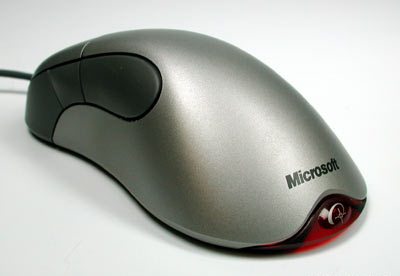Optical Mouse..
— Indeed Every House needs a Mouse…!!
One of the most familiar one in our daily lives.. r8…??
– Have you ever thought.? How it all works..??
Lets have a view on it…
Today..
It appears that the vunerable wheeled mouse is in danger of extinction. The
now-preferred device for pointing and clicking is the optical mouse.
First Developed by Agilent Technologies and introduced to the
world in late 1999.
The optical mouse actually uses a tiny camera to take 1,500 pictures every
second…!! And hence able to work on almost any surface, the mouse has a
small, red light-emitting diode (LED) that bounces light off that surface onto
a complementary metal-oxide semiconductor (CMOS) sensor.

Sensing Mechanism Of Mouse
The CMOS sensor sends each image to a digital signal processor
(DSP) for analysis. The DSP, operating at 18 MIPS (million
instructions per second)…!!
It is able to detect patterns in the images and see how those patterns have
moved since the previous image. Based on the change in patterns over a sequence
of images, the DSP determines how far the mouse has moved and sends the
corresponding coordinates to the computer. The computer moves the cursor on the
screen based on the coordinates received from the mouse.
This happens hundreds of times each second, making the cursor appear to move
very smoothly…!!
-
Optical mice have several benefits over wheeled mice :
- No moving parts means less wear and a lower chance of failure.
- There’s no way for dirt to get inside the mouse and interfere with
the tracking sensors.
- Increased tracking resolution means smoother response.
- They don’t require a special surface, such as a mouse pad.
Although LED-based optical mice are fairly recent, another type of optical
mouse has been around for over a decade..!!
The original optical-mouse technology bounced a focused beam of light off a
highly-reflective mouse pad onto a sensor. This mouse pad had a grid of dark
lines. Each time the mouse was moved, the beam of light was interrupted by the
grid. Whenever the light was interrupted, the sensor sent a signal to the
computer and the cursor moved a corresponding amount. This kind of optical
mouse was difficult to use, requiring that you hold it at precisely the right
angle to ensure that the light beam and sensor aligned..!!
Also, damage to or loss of the mouse pad rendered the mouse useless until a
replacement pad was purchased.
Today’s LED-based optical mice are far more user-friendly and reliable.

Touch Screen..
A revolutionary idea of the modern era
making technology smarter…
How it all works…??
Lets have a Look on…!!

